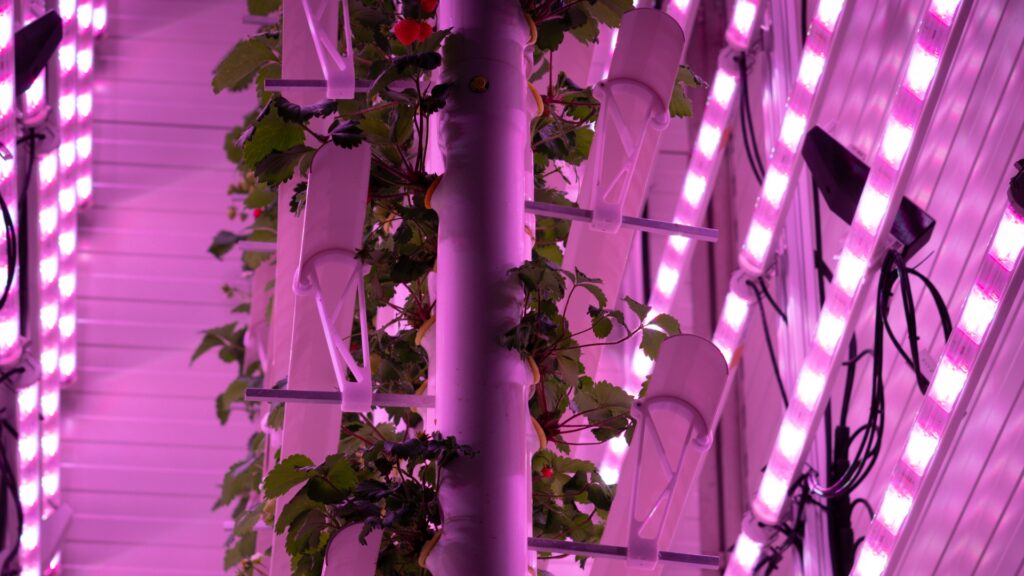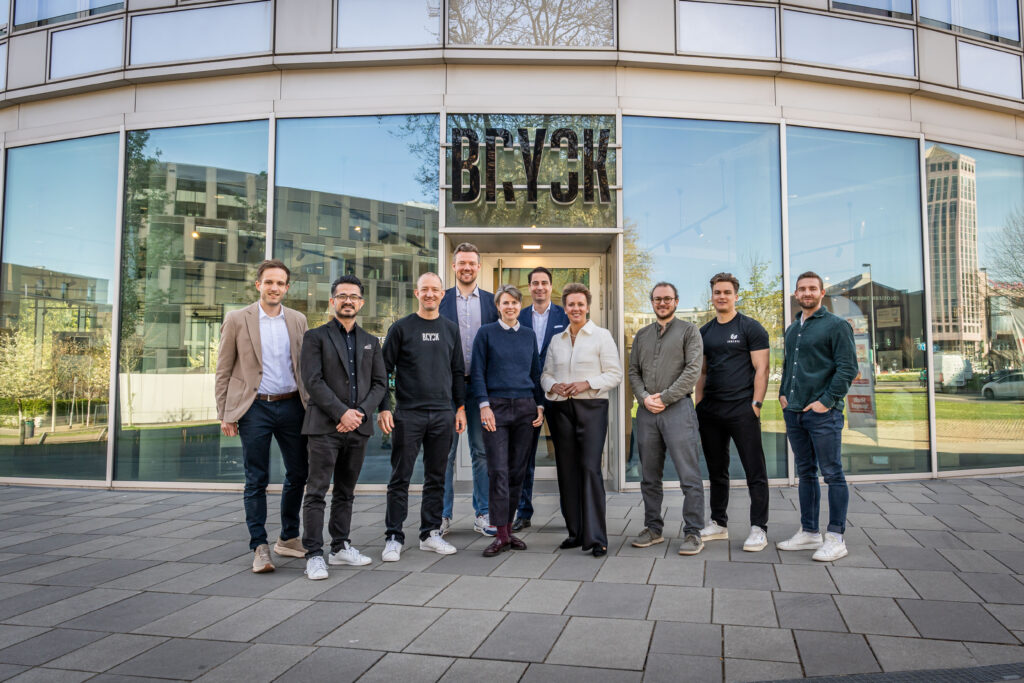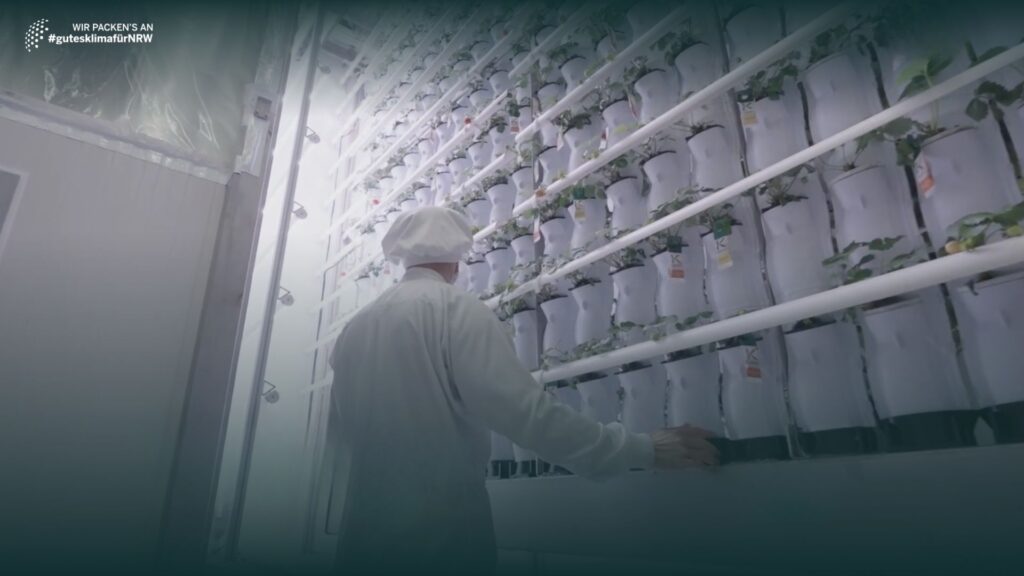The food industry is currently undergoing a major transformation. New, modern technologies are reshaping agriculture to tackle pressing issues. Vertical farming is such a technology with enormous potential.
However, this potential is not limited to just growing fruits and vegetables—combined with the power of artificial intelligence (AI), vertical farming can achieve much more. More than just a new method for indoor crop cultivation, vertical farming opens up unprecedented opportunities for data collection and analysis.
With AI-driven technologies, these farms not only optimize plant growth but also generate vast amounts of data that help refine the entire process, making food production more efficient, sustainable, and scalable.
In this article, we explore how the integration of AI in vertical farming is revolutionizing the way we grow and manage crops, and how the data collection capabilities of vertical farms can and will transform the food industry.
Table of contents:
- What Is Vertical Farming?
- How to Use AI in Vertical Farming
- Advantages of Using AI in Vertical Farming
- The Revolution of Plant Production through AI and Data
- Conclusion
What Is Vertical Farming?
Vertical farming is a modern cultivation method where food, such as fruits and vegetables, is grown in indoor farms using vertical arrangements under controlled conditions.
This technology, which has been increasingly pursued and intensively developed in recent years, holds tremendous potential for the food sector and presents an innovative and promising solution to the growing challenges of food production. According to estimates, the global vertical farming market is expected to reach over 35 billion by 2032.
Vertical farming should never be seen as an isolated method but rather as a complement to traditional agriculture. It offers significant advantages that help address the current challenges of conventional farming and ensures the food supply chain for the population in the future.
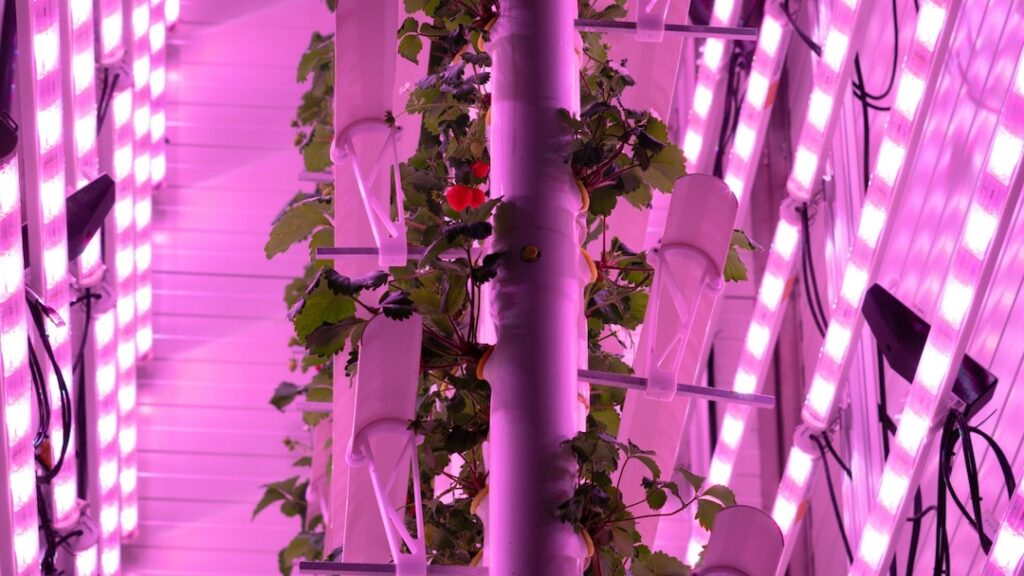
Indoor vertical farming relies on controlled systems for light, temperature, and nutrients, allowing crops to be grown in urban areas with reduced transportation needs. Therefore one of the greatest benefits of vertical farming is its sustainability. The controlled environment drastically reduces water usage and pesticide application. Additionally, land use is optimized by growing plants vertically rather than on traditional horizontal fields.
Furthermore, the technology opens up new possibilities for data analysis in agriculture. Sensors and automated systems can monitor plant growth in real-time, leading to more efficient resource use. By leveraging artificial intelligence (AI), data collection can be intensified, allowing for continuous optimization of growing conditions.
How to Use AI in Vertical Farming
AI is a key component of successful vertical farming technology, as seen in the advancements made by startups like vGreens. AI plays a central role in the production of food in indoor farms—as used in vGreens’ vertical strawberry farms—by enabling their seamless operation in the first place.

Specifically, AI can be utilized in various aspects of vertical farming:
- Environmental Control: AI systems, aided by sensors, can continuously monitor and automatically regulate various parameters like temperature, light, humidity, and CO₂ levels in the vertical farm, ensuring optimal growing conditions and quality control without human intervention.
- Scenario Testing: AI can simulate growth processes in the vertical farm and test different scenarios to determine which conditions lead to the best yields. These simulations enable constant improvements in cultivation strategies.
- Predictive Analysis: Using historical data, AI can detect potential issues, such as nutrient deficiencies or pest infestations, early on and initiate proactive measures before crop yields are affected.
- Resource Optimization: AI can optimize resource use, including water and fertilizers, to minimize waste and reduce the environmental footprint.
- Market Analysis: AI can analyze market data and consumer trends, allowing the vertical farm to adjust their production to meet current demand. This helps avoid overproduction and ensures the sale of fresh products.
The use of AI in vertical farms represents an alternative to traditional recipe-based farming, where pre-programmed instructions guide food production. Instead, AI makes data-driven, real-time decisions about which environmental parameters are needed at specific times, based on the dataset it continually processes.
But can AI truly overcome the complexities of indoor farming and deliver on the promise of efficient, on-demand crop production?
Advantages of Using AI in Vertical Farming
At vGreens, we believe the answer to this question is a resounding yes. AI opens up an entirely new dimension of precision, adaptability, and long-term efficiency that simply cannot be matched by conventional tools.
Here’s why AI, not the conventional recipe growing, is crucial for revolutionizing vertical farming and enabling truly on-demand production:
- Dynamic Decision-Making
- Self-Learning Capabilites
- Predivitive Capabilites for Proactive Farming
- Handling Complex Relationships in Growth Phases
- Scalability and Customization Across Locations
- Continuous Optimization for Sustainability
Dynamic Decision-Making
Traditional recipes follow a set of pre-programmed instructions. It can automate tasks, but it lacks the flexibility to adapt to frequently changing plant demands without manual reprogramming. AI, on the other hand, processes vast amounts of data in real-time and makes decisions dynamically.
In vertical farming, plant demands change frequently, whether due to slight variations in temperature, humidity, or even plant health. AI can quickly detect these changes and adjust conditions automatically. This real-time adaptability ensures that plants are always growing under optimal conditions without human intervention, while conventional software would require ongoing manual input to handle such changes.
Self-Learning Capabilities
One of the most powerful advantages of AI is its ability to learn and improve over time. With each crop cycle, the AI gathers more data about what works best for the specific plant variety, growth phases, and environmental conditions. This continuous learning process allows the AI to become more accurate and efficient, optimizing everything from nutrient delivery to light cycles as it gathers more data.
Traditional recipes can only operate within the pre-defined parameters set by its operators. Improvement is limited by the observation horizon of the operator. AI, on the other hand, becomes smarter with every iteration and integrates data from multiple locations, meaning your farm is not just automated—it’s self-improving. This is critical for vertical farming, where conditions can vary from one facility to another and optimization is key.
Predictive Capabilities for Proactive Farming
AI excels in predictive analytics, enabling farmers to anticipate issues before they arise. By analyzing trends in real-time data, AI systems can predict plant stress, or suboptimal growing conditions before they impact the crop. This allows for proactive adjustments—whether in nutrient levels, lighting, or irrigation—preventing yield loss and improving overall farm performance.
In contrast, traditional growing is reactive to preset thresholds but cannot predict future problems or opportunities. This reactive nature can lead to inefficiencies or missed opportunities for improvement. With AI, however, farms become proactive rather than reactive, making production far more reliable and efficient.
Handling Complex Relationships in Growth Phases
Plant growth is a complex process involving numerous interdependent factors like light, temperature, nutrients, and water. These factors affect both the vegetative and generative (fruiting) phases in intricate ways. AI can manage these complex relationships because it excels at processing vast datasets and identifying patterns that humans might miss.
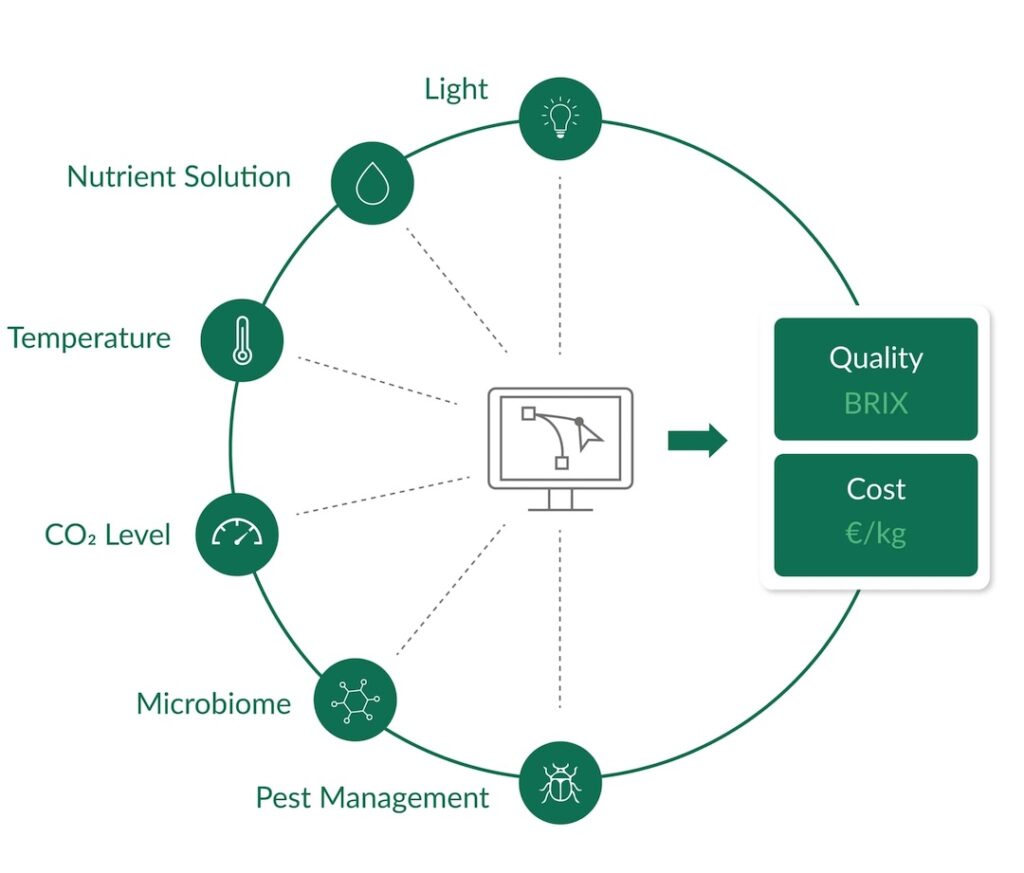
For example, AI can optimize spectral compositions at different stages of growth, adjusting dynamically based on real-time plant feedback. It can also analyze plant health metrics across thousands of plants simultaneously, adjusting variables to ensure consistent growth across the entire facility. Traditional recipes simply cannot manage this level of complexity and frequency, as it would require manual reprogramming for each potential scenario.
Scalability and Customization Across Locations
AI offers the ability to scale and customize growing strategies across multiple facilities and plant types. It learns from the specific conditions of each farm and tailors its algorithms to optimize production accordingly.
This scalability is nearly impossible with recipe growing, which would require intervention and interpretation for the transfer from one location to the next. AI, by contrast, can adapt and transfer its knowledge from one facility to another, making it infinitely scalable across geographies and different crops, with minimal human input.
Continuous Optimization for Sustainability
Sustainability is at the heart of vertical farming, and AI plays a key role in ensuring that resources like water, energy, and nutrients are used as efficiently as possible. By continuously analyzing the farm’s performance and making real-time adjustments, AI can minimize resource waste, reduce energy consumption and maximize yield—something that static, rule-based recipes cannot achieve on its own.
AI not only optimizes the current crop cycle but learns from historical data to improve future resource allocation. This ability to continuously optimize resource use makes AI indispensable for creating a sustainable and highly efficient farming system.
The Revolution of Plant Production through AI and Data
Vertical farming presents itself as a promising solution to make plant production more efficient and sustainable. While much attention is rightfully given to the fruits and vegetables that can be grown using these modern farming methods, there is another key aspect at the heart of vertical farming’s development: the immense potential of data collection.
Data Collection in Vertical Farms with AI
In today’s digital world, data is one of the most valuable resources. It provides insights into individual behaviors and preferences and serves as crucial information for companies to make informed decisions. In food production, data is equally invaluable, but until a few years ago, gathering this data posed a significant challenge.
Vertical farming technology opens up new possibilities for data collection in the food sector. The true strength of vertical farms lies not only in the physical cultivation of plants and thus food, but also in the gathering and utilization of data.
With the AI employed in a vertical farm, every new dataset from the farms and each new plant growth cycle enables further data collection, improving our understanding of the food production process. As more farms come online and more food is cultivated within them, the data pool expands, providing new insights into food production on a grand scale.
Transformation of the Food Industry
This new method of data collection through vertical farms is unique. Vertical farming allows for data to be gathered on a scale that would never be possible in traditional fields or greenhouses, offering countless new insights into crops and their growing processes.
At vGreens, we recognize the immense potential of these new technological capabilities. Our vision is to collect as much data about plants as possible and to optimize the cultivation of various plants to such an extent that the production of fruits and vegetables under perfect conditions can be realized anytime, anywhere. The goal is to develop a system that, with the help of AI, creates optimal growth conditions for plants at the push of a button—enabling a completely new and revolutionary approach to food production.
Data Collection Using Strawberries as an Example
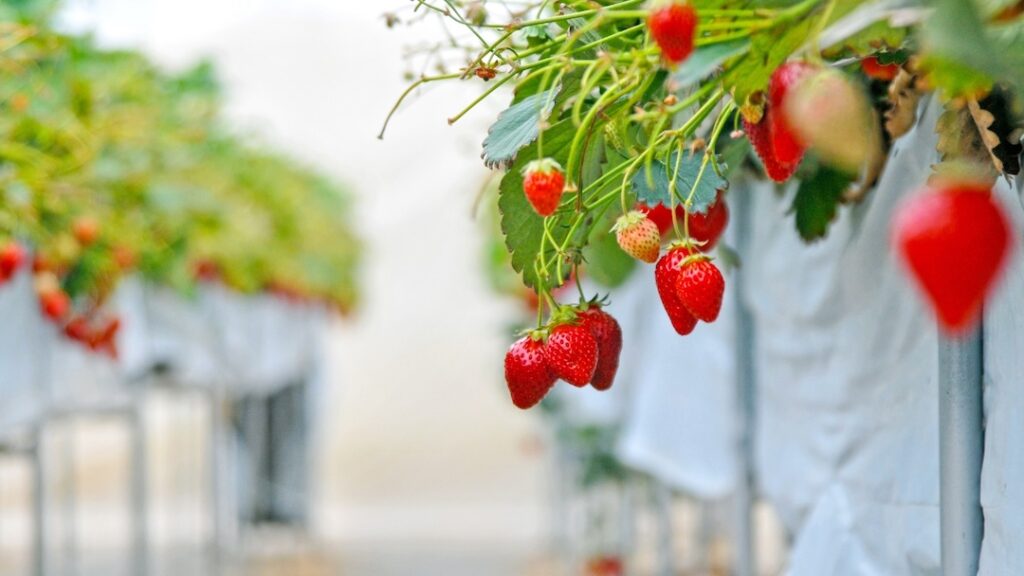
This new form of food production, made possible by data collection and optimization of production conditions, is particularly relevant for fruits like strawberries, which we cultivate in our vertical farms at vGreens. While leafy greens grow relatively well in controlled environments, the cultivation of fruits like strawberries is far more complex.
The challenge lies in the greater biological complexity of fruits and the fact that there are currently few approaches that successfully address the needs of fruit-bearing plants in vertical farms. In short: we still don’t know enough about strawberries.
The potential of data collection becomes especially clear in this context. By gathering extensive data, our understanding of strawberry growth increases, allowing the “strawberry recipe” to be continually refined and made more precise. With AI, top-quality strawberries can be produced swiftly and efficiently.
Conclusion
The fusion of artificial intelligence and vertical farming is driving a significant shift in the food industry. While vertical farming alone offers a sustainable and efficient method of crop production, it is the integration of AI that truly unlocks its full potential. By collecting and analyzing vast amounts of data, AI-driven vertical farms can optimize growing conditions in real-time, predict potential challenges, and continuously refine the entire cultivation process.
This data-centric approach not only enhances efficiency and sustainability but also provides insights that were previously unimaginable in traditional agriculture. As more vertical farms emerge and AI technologies evolve, the opportunities for data collection and analysis will continue to expand, pushing the boundaries of what’s possible in food production.



